Attached files
| file | filename |
|---|---|
| 8-K - 8-K - HERON THERAPEUTICS, INC. /DE/ | d925609d8k.htm |
 Company Update
May 2015
Exhibit 99.1 |
 2
Legal Disclaimer
This presentation contains "forward-looking statements" as defined by
the Private Securities Litigation Reform Act of 1995. These
forward-looking statements involve risks and uncertainties, including
uncertainties associated with the development, regulatory approval,
manufacture, launch and acceptance of new products, completion of clinical
studies and the results thereof, the ability to establish strategic
alliances and/or acquire desirable assets, progress in research and
development programs and other risks and uncertainties identified in the
Company's filings with the Securities and Exchange Commission. Actual
results may differ materially from the results anticipated in our forward
looking statements. We caution
investors that forward-looking statements reflect our analysis only on their
stated
date.
We
do
not
intend
to
update
them
except
as
required
by
law. |
 3
Status of Development Programs
Preclinical
Phase 1
Phase 2
Phase 3
NDA
Intravenous
NK
1
for CINV
CINV: Acute-
and Delayed-Onset after MEC, and Acute-Onset after HEC
SUSTOL
(APF530)
SUSTOL
(APF530)
HTX-019
HTX-011
CINV: Delayed-Onset after HEC
Will be evaluated in soft
tissue, nerve block, and
orthopedic indications
Bupivacaine + meloxicam for
post-operative pain
HTX-003
30-Day Buprenorphine for
chronic pain and addiction
505(b)(2) registration pathway
should lead to NDA filing 2H2016 |
 CINV
FRANCHISE |
 5
CINV Highlights
•
SUSTOL
®
(granisetron injection, extended release), is a long-acting, injectable
product for the prevention of chemotherapy-induced nausea and vomiting
(CINV) –
1,341-patient, randomized, controlled, Phase 3 study demonstrated activity in
acute-and delayed-onset CINV after moderately emetogenic
chemotherapy (MEC), and acute-onset CINV after highly emetogenic
chemotherapy (HEC) –
MAGIC: Enrollment of over 900 patients completed March. Designed
to obtain
delayed-onset CINV indication in patients receiving HEC. No injectable
5-HT 3
agents currently approved for prevention of delayed-onset CINV after HEC
•
HTX-019
is a proprietary intravenous (IV) formulation of aprepitant, an
NK
1
receptor
antagonist
and
is
distinguished
from
the
only
IV
NK
1
receptor
antagonist
presently approved in the U.S. in that it does not contain polysorbate 80, which
may cause infusion site reactions, hypersensitivity or other adverse
reactions in some patients.
•
Rapid development utilizing the 505(b)(2) registration pathway is anticipated to
achieve NDA submission in 2H2016 |
 6
5-Day Profile: APF530 Pharmacokinetics
Granisetron is released rapidly following injection of APF530 and continues to be
released for 5-days, providing long-acting coverage for CINV
*Data from patent application 20120258164 for transdermal granisetron
0
5
10
15
20
0
24
48
72
96
120
144
168
Time after Dosing (h)
All subjects (n= 18)
mean ±
SEM
Minimum
therapeutic
concentration of
granisetron* |
 7
SUSTOL Pivotal Phase 3 Study
Overview
•
Randomized, controlled, multi-center study
•
1,341 patients in primary efficacy population
•
Two doses of APF530 (5 mg and 10 mg granisetron)
compared to the approved dose of Aloxi
®
(results from 10
mg dose group presented)
•
Patients stratified by type of chemotherapy regimen: MEC
or HEC
•
Primary end point compared complete response between
groups in both the acute (day 1) and delayed (days 2-5)
phase
–
Complete response defined as no emesis and no rescue medications
–
±15% margin used to establish non-inferiority
|
 8
Primary Efficacy Results: Complete
Response
Patients Receiving Moderately
Emetogenic Chemotherapy
-
+
Acute
Delayed
APF530 10mg
Acute
Delayed
Difference in Complete Response
APF530-Aloxi (97.5% CI)
-15
-10
-5
0
5
10
15 |
 9
Primary Efficacy Results: Complete
Response
Patients Receiving Highly
Emetogenic Chemotherapy
Difference in Complete Response
APF530-Aloxi (98.33% CI)
-15
-10
-5
0
5
10
15
Acute
Delayed
APF530 10mg
Acute
Delayed
-
+ |
 10
Safety Summary
•
1
Safety results with the 5 mg dose of APF530 studied in separate arm of the phase 3
study are not included •
2
>90% of injection site reactions were reported as mild; one patient
discontinued due to injection site reaction Cycle 1 Safety Results
APF530 10 mg
1
Aloxi 0.25 mg
N
%
N
%
Drug Related Serious Adverse Events
0
0
0
0
Discontinued Due to Adverse Event
1
0.2
0
0
Frequent Adverse Events
Gastrointestinal Disorders
Constipation
Diarrhea
Abdominal pain
72
44
13
15.4
9.4
2.8
62
39
28
13.4
8.4
6.0
Nervous System
Headache
47
10.0
45
9.7
Injection Site
2
Placebo (NaCl)
Bruising
Erythema (redness)
Nodule (lump)
Pain
93
51
50
33
19.91
0.9
10.7
7.1
41
14
3
5
8.9
3.0
0.6
1.1 |
 11
FDA-Requested
ASCO
2011
Reanalysis
Improves Difference Between SUSTOL and
Aloxi in HEC Patients
Protocol Specified HEC Population
ASCO 2011 Guideline HEC Population
Acute
Delayed
Acute
Delayed |
 12
CR Rates by Treatment
Chemotherapeutic Regimen
APF530 10 mg
Aloxi 0.25 mg
Moderately
Emetogenic
Acute
Cyclophosphamide/Doxorubicin
70.7%
65.7%
All other regimens
84.4%
85.0%
Delayed
Cyclophosphamide/Doxorubicin
47.4%
46.3%
All other regimens
72.9%
70.0%
Highly
Emetogenic
Acute
Cisplatin regimens
81.1%
75.5%
Carboplatin/Paclitaxel
85.4%
89.8%
All other regimens
75.4%
67.6%
Delayed
Cisplatin regimens
66.0%
60.4%
Carboplatin/Paclitaxel
70.8%
71.4%
All other regimens
65.2%
57.4%
Largest Differences Between Arms is Seen
With Most Difficult Chemo Regimens
•
1
Data from post-hoc analysis. Not statistically significant.
•
Highlighted HEC regimens were considered HEC in both protocol specified Hesketh
and 2011 ASCO Guidelines
12
1 |
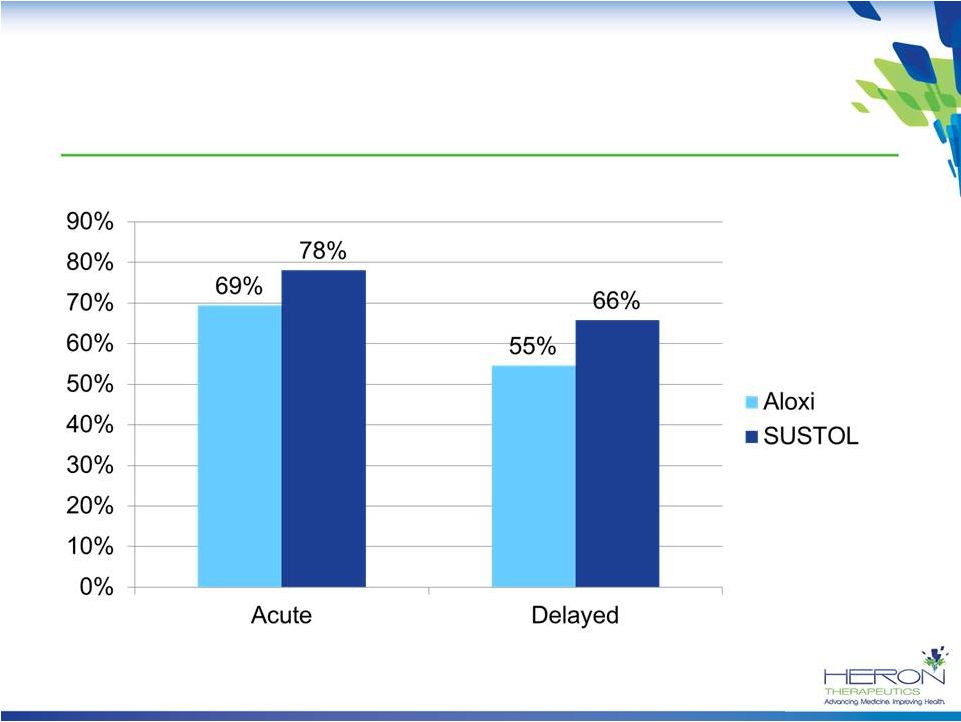 13
Response Rates With Chemotherapy Classified
as HEC by Both Hesketh and 2011 ASCO*
*Cisplatin, carmustine, dacarbazine, dactinomycin, mechlorethamine,
streptozotocin SUSTOL reflects 9-11% greater response rate in the most
emetogenic chemotherapy |
 14
A Delayed-HEC Indication Would Provide
Clear Differentiation in an Important
Segment of the CINV Market
1
IntrinsiQ data from July 2012 –
June 2013
14
HEC regimens account for
~20% (500K) of
palonosetron administrations
This is the same segment of
the CINV market where NK
receptor antagonists are
extensively used
Distribution of Aloxi Sales
HEC
Minimal
LEC
MEC
1
1 |
 15
Phase 3 “MAGIC”
Study
> 900 patients
received HEC*
randomized 1:1
Ondansetron 0.15 mg/kg IV (up to 16 mg IV) d 1
+ fosaprepitant 150 mg IV d 1 + DEX
+ placebo SC d1
APF530 500 mg SC d 1
+ fosaprepitant 150 mg IV d 1 + DEX
+ placebo IV d 1
Cycle 1
1.
All subjects will receive dexamethasone 12 mg IV on day 1 and 8 mg PO BID on days
2-4 2.
All
subjects
will
be
allowed
to
receive
“rescue”
medications
as
required
at
the
discretion
of
their
treating
physician
*HEC agents as defined in the 2011 ASCO CINV guidelines.
Superiority design assuming a CR rate of 65% in the control
(ondansetron) arm, a binary endpoint (CR or no CR), a 2-sided
alpha = 0.05 to test 65% vs 75%; for 90% power you need 880
evaluable patients
15 |
 16
New SUSTOL Study Strategically Designed
Based on Previous Results
^^Average
Complete
Response
rate
improvement
adding
NK-1
RA
to
5-HT
3
RA
and
Dexamethasone
is
~15
-
20%
in
the
delayed
HEC
*Poll-Bigelli; Cancer, 97:12, 3090, 2003
**Projection of what would happen with a 20% increased response by addition of fosaprepitant to Sustol +
Dex Projected
Response
with addition
of NK
1
^^
Study
powered
to show 10%
difference:
65% vs 75%
APF530 + Dex
+ Fosaprepitant**
APF530+Dex
Ondansetron + Dex
+ Fosaprepitant*
Ondansetron + Dex*
Standard of Care
Phase 3 Study
HEC Study
67%
65%
45%
Study powered for a 10% difference between arms
20% difference is expected with the addition of fosaprepitant,
75%
87%
0
10
20
30
40
50
60
70
80
90
100 |
 17
HEC Study Update
•
Enrollment closed end of March 2015,
with over 900 patients enrolled
•
NDA resubmission at mid-year 2015
•
FDA has previously indicated that a
positive outcome from this study would
be sufficient to obtain “delayed-HEC”
indication |
 18
SUSTOL Has the Potential to be the Next
Generation 5-HT
3
Receptor Antagonist
5-HT
3
RAs
1
st
generation
2
nd
generation
3
rd
generation
Products
ondansetron
granisetron
palonosetron
SUSTOL
Duration of
action
Short acting
~ 8 hr half-life
Longer acting
~40 hr half-life
Long acting
PK profile 5-7 days
Indications
Prevention of CINV in
emetogenic chemo including
high-dose cisplatin
MEC –
acute & delayed CINV
HEC –
acute CINV
MEC –
acute & delayed CINV
HEC –
acute & delayed CINV*
*Obtaining delayed HEC dependent on results of ongoing SUSTOL trial
|
 SUSTOL REGULATORY
STATUS |
 20
SUSTOL NDA Status
NDA resubmitted in September 2012
•
CMC: correction of PAI issues and revision of one in-vitro
release method
•
Requirement for Human Factors Validation Study with
commercial product
•
Re-analysis of the existing Phase 3 study using the ASCO
2011 guidelines for categorization of MEC and HEC
–
Received Complete Response Letter March 2013 raising three main
issues: |
 21
How We Are Addressing the CRL
•
Chemistry, Manufacturing, and Controls
–
Sites with PAI issues have been eliminated from the supply chain, with work
transferred to a well-established site with no PAI issues
•
Transition
is
complete,
with
secondary
benefit
of
improvement
in
the
COGS
–
New in-vitro release method has been developed and validated
–
Multiple validation batches of finished product have now been completed
•
Human Factors Validation Study
–
Successfully completed
•
Re-analysis of Phase 3 using new ASCO 2011 Guidelines
–
Re-analysis complete
–
Complete dataset and programs supplied to FDA and found acceptable
•
NDA resubmission expected mid-year 2015 |
 22
HTX-019: Aprepitant IV
•
HTX-019
is
a
proprietary
IV
formulation
of
aprepitant,
an
NK
1
receptor
antagonist.
NK receptor
antagonists
are
recommended
to
be
used
in
combination
with
5-HT
3
receptor
antagonists
for
prevention
of
CINV
•
Primary Composition of Matter patent protection of aprepitant expired April
2015
–
Secondary patent on polymorpic form not relevant to intravenous formulation
•
The
other
commercially
available
IV
NK
1
receptor
antagonist
contains
polysorbate 80, which has been shown to cause infusion site reactions,
hypersensitivity
and
other
reactions
in
some
patients .
HTX-019
is
polysorbate 80 free and may avoid some of these adverse reactions.
•
Product should receive a unique J-code and compete directly with
EMEND
®
IV
(fosaprepitant)
•
Rapid development utilizing the 505(b)(2) registration pathway is
anticipated to achieve NDA submission in 2H2016 based on
bioequivalence (to be discussed with FDA)
1. LA Norris, et al. 2010 COMMUNITY ONCOLOGY; Polysorbate 80 hypersensitivity
reactions: a renewed call to action
1
1 |
 CINV FRANCHISE
COMMERCIAL OPPORTUNITY |
 24
Commercial Opportunity Summary
Market
•
Heron has the opportunity to establish a long-term, dominant position in a CINV
market
targeting
3.6M
units
of
IV
5-HT
3
and
NK
1
annually
•
The
NK
1
market
grew
10%
YOY
in
2013
with
significant
opportunity
for
increased
penetration into MEC regimens
Competitive
Landscape
•
New branded, injectable agents will be well-positioned to gain significant share
as current market leaders (Aloxi, EMEND) lose patent protection
•
SUSTOL
positioned
to
be
the
only
branded
injectable
5-HT
on
the
market
following
Aloxi’s
patent expiry in 2015
•
HTX-019 anticipated to be similarly positioned following EMEND’s patent
expiry in 2019 Go-To-Market
Strategies
•
Differentiate SUSTOL and HTX-019 clinically to drive uptake
•
SUSTOL
targeted
to
be
the
first
and
only
injectable
5-HT
indicated
for
the
prevention
of
acute
and
delayed
CINV
in
both
MEC
and
HEC
•
HTX-019 has potential to differentiate vs. IV EMEND based on polysorbate
80-free formulation •
Leverage a highly synergistic CINV portfolio to maximize return on investment
•
~600 practices account for ~90% of both Aloxi and IV EMEND use in clinic
segment •
SUSTOL-targeted practices are the highest users of IV EMEND
•
Highly leveraged cost effective commercial footprint
3
3 |
 25
Heron has the opportunity to establish a long-term,
dominant position in a CINV market that has over
3.6M penetrable units
Q2'13
Q4'13
Injectable Drugs for the Prevention of CINV
Number of Package Units Sold by Quarter
ALOXI
ANZEMET
KYTRIL
KYTRIL Generic (GRANISETRON)
ZOFRAN
ZOFRAN Generic (ONDANSETRON)
EMEND
800,000
0
100,000
200,000
300,000
400,000
500,000
600,000
700,000
Q2'06
Q4'06
Q2'07
Q4'07
Q2'08
Q4'08
Q2'09
Q4'09
Q2'10
Q4'10
Q2'11
Q4'11
Q2'12
Q4'12
Aloxi
EMEND
Data is Package Units; Ondansetron units reflect only 2 mg/ml and 32mg/50 ml strength
sizes |
 26
New branded, injectable agents will be well-
positioned to gain significant share as current
market leaders (Aloxi, EMEND) lose patent protection
Candidate
Class
Indication
Sponsor
Possible
Launch
AKYNZEO
®
Oral FDC combines netupitant
(NK
1
) with palonosetron (5HT
3
)
Prevention of CINV in MEC/HEC
Eisai /
Helsinn
Launched Q4 2014
Generic
palonosetron
IV 5-HT
3
MEC –
acute & delayed CINV
HEC –
acute CINV
TBD
(multiple)
Oct 13, 2015
Ongoing litigation
Rolapitant
Oral / IV NK
1
Prevention of delayed onset CINV in
MEC/HEC (to be used in combination
with 5-HT
3
)
Tesaro
Oral mid-2015
IV Q3 2016
Generic
fosaprepitant
IV NK
1
Prevention of CINV in MEC/HEC (to be
used in combination with 5-HT
3
)
TBD
(multiple)
Q1 2019
2014
2015
2016
AKYNZEO
(oral)
Rolapitant??
(oral)
Rolapitant??
(IV)
2017
2018
2019
fosaprepitant
patent expiry
palonosetron
patent expiry |
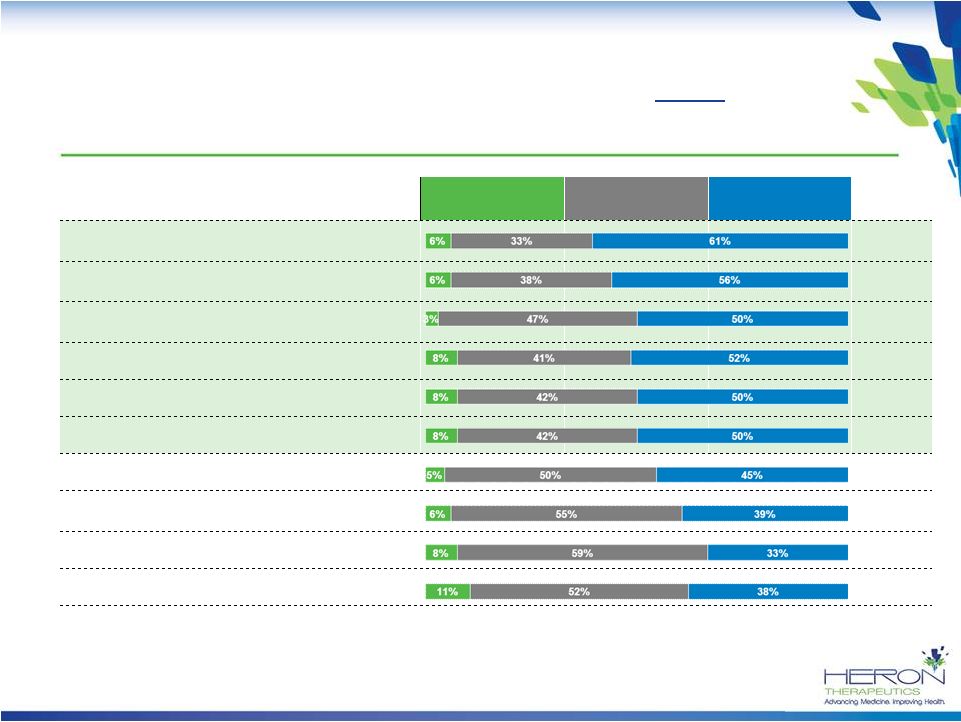 27
SUSTOL would be the first and only injectable 5-HT
3
indicated for acute and delayed CINV in both
MEC
and HEC favored by more than 50% of oncologists
Attribute
Favor IV Aloxi (1-2)
No Preference (3)
Favor SUSTOL (4-5)
Avg. (N=66)
Effective for prevention of delayed CINV in assoc. with HEC
3.65
Is long-acting, with an extended PK profile
3.62
Provides consistently durable efficacy for over 5 full days
3.53
Effective for prevention of delayed CINV in assoc. with MEC
3.48
Has low rates of breakthrough CINV
3.47
Minimizes amount of rescue medication required
3.44
Demonstrates sustained efficacy over multiple chemo cycles
3.44
Effective for prevention of acute CINV in assoc. with HEC
3.32
Well tolerated, with a low risk of side effects
3.32
Effective for prevention of acute CINV in assoc. with MEC
3.27
MD PMR Q29: Please rate the extent to which you favor SUSTOL versus IV Aloxi
(palonosetron) on each of the following attributes using a 5- point
scale, where 1= Strongly favor IV Aloxi (palonosetron) over SUSTOL and 5 = Strongly favor SUSTOL over IV Aloxi (palonosetron) [SS] |
 HEC
Regimens Represent a Significant Market Opportunity for SUSTOL and
HTX-019 Source:
IntrinsiQ
data
from
July
2012
–
June
2013
HEC Regimens Account For ~20%
(500K) of Palonosetron Administrations
Of All HEC Administrations, ~20% Are
Given
Without
Concomitant
IV
5-HT
3
–
Inconsistent With Clinical Guidelines
497,256
1,463,558
451,490
111,696
-
200,000
400,000
600,000
800,000
1,000,000
1,200,000
1,400,000
1,600,000
HEC
MEC
LEC
Minimal
-
200,000
400,000
600,000
800,000
1,000,000
1,200,000
Annual HEC
administrations
Untreated with
IV 5HT3
Treated with
generic IV 5HT3
Treated with
Aloxi
317,915
188,988
497,256
28 |
 POST-OPERATIVE PAIN
PROGRAM |
 30
Heron Post-Operative Pain Program
Target Product Profile for Best-in-Class Product:
An
injectable
pain
therapeutic
that
utilizes
proprietary
Biochronomer
®
polymer-based
drug delivery platform technology
Designed to deliver both bupivacaine (anesthetic) and meloxicam
(anti-inflammatory) evenly over 2-3 days without a large initial
peak HTX-011 builds on other innovations in the category and has
best-in-class potential
Introducing HTX-011:
Maximal pain relief that lasts for 2-3 days
Maximal reduction of opioid use
Maximal reduction of length of hospital stay
Elimination of dose-limiting peak of bupivacaine
Easy to use for a large variety of procedures
Does not require refrigeration or special handling |
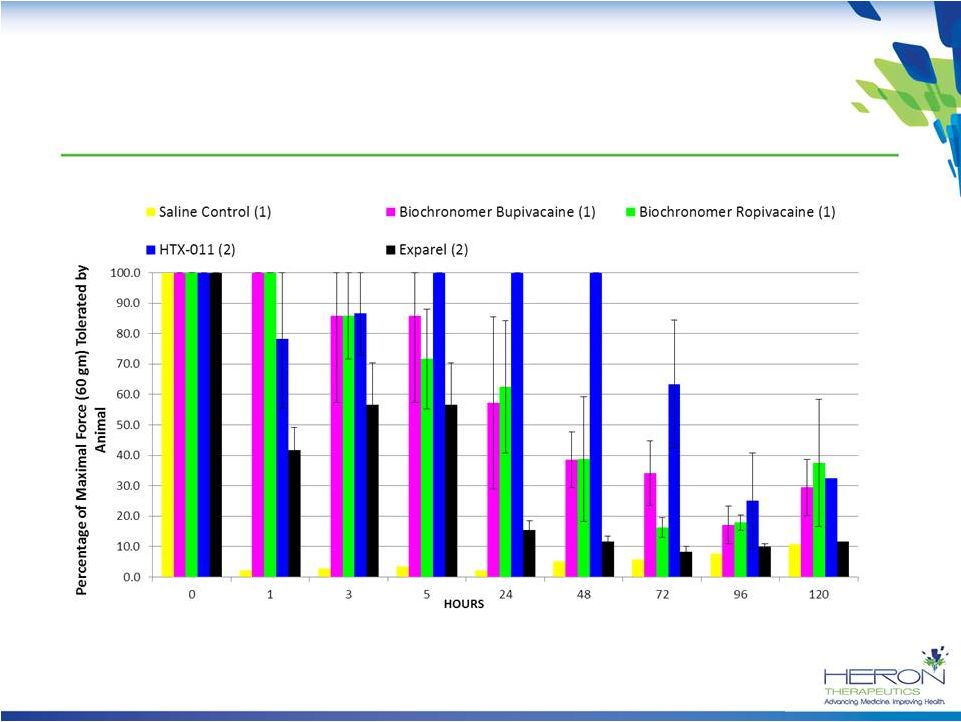 31
HTX-011 Significantly Superior to EXPAREL
at 24-72 Hours
1.
Study #1; All studies used the post-operative pain model in pigs from Castle et
al, 2013 EPJ Pig Post-Operative Pain Model
(n=4 pigs, except at 120 hrs for Study #2: preliminary results from 2 animals)
2.
Study #2 compared <½ expected human dose of Biochronomer bupivacaine/meloxicam formulation to
the human dose of EXPAREL
®
(40% smaller incision used with EXPAREL) 31
|
 32
HTX-011 Shows Durable Response in Sciatic
Nerve Block Model in Pigs |
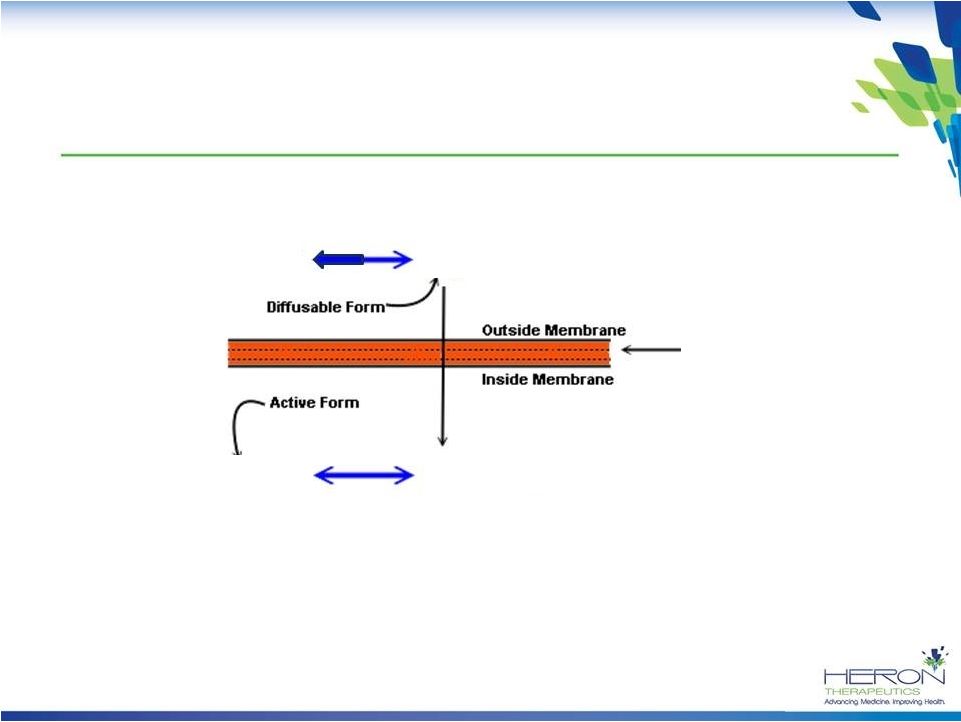 33
Local Anesthetics Exist in a Balance Between
Water-Soluble and Lipid-Soluble Forms
•
Local anesthetics have pKa values > 7.4, so at normal
physiologic pH of 7.4, the majority of molecules exist as the
water-soluble quaternary salt not able to penetrate nerve cell
membrane
Water-Soluble
Ionized Form
Lipid-Soluble Un-
Ionized Form
Local
anesthetic
nerve
penetration
model
adapted
from
Becker
and
Reed,
Anesth
Prog
53:98–109
2006
BUPH
+
BUPN + H
+
BUPH
+
BUPN + H
+
Nerve Cell
Membrane |
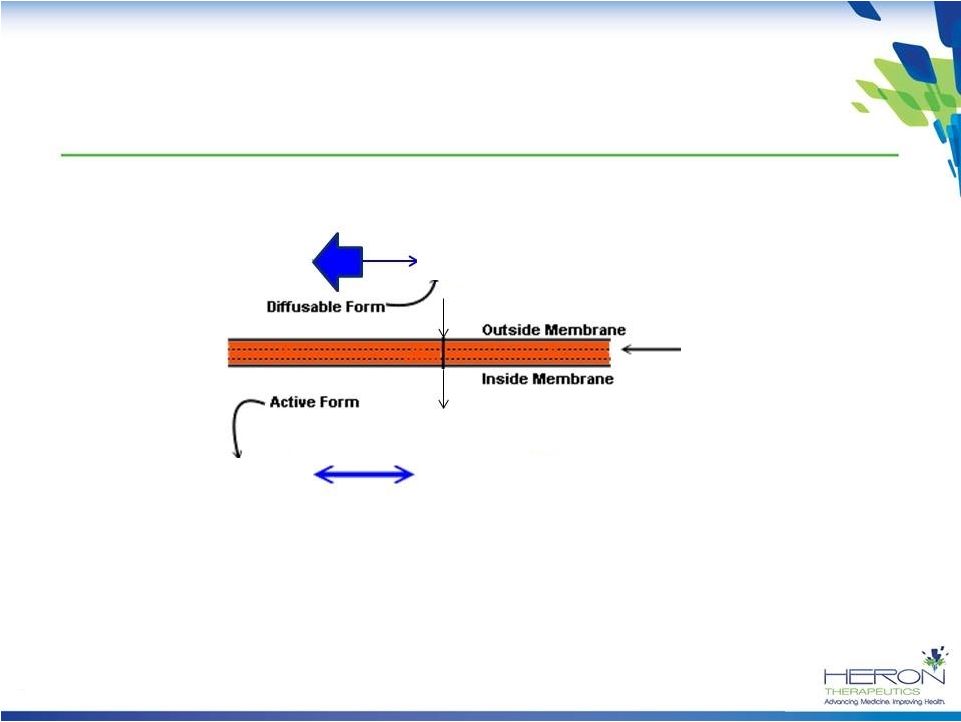 34
Local Anesthetics Exist in a Balance Between
Water-Soluble and Lipid-Soluble Forms
•
The acidic environment associated with inflammation shifts the balance
further to the left, resulting in far less drug penetrating the nerve
membrane and reduced anesthetic effects.
•
With a pKa of 8.1, bupivacaine is very sensitive to reduced pH
Acidic Environment Shifts the Balance to Ionized Form Unable
to Penetrate Nerve Cell Membrane
Local
anesthetic
nerve
penetration
model
adapted
from
Becker
and
Reed,
Anesth
Prog
53:98–109
2006
BUPH
+
BUPN + H
+
BUPH
+
BUPN + H
+
Nerve Cell
Membrane |
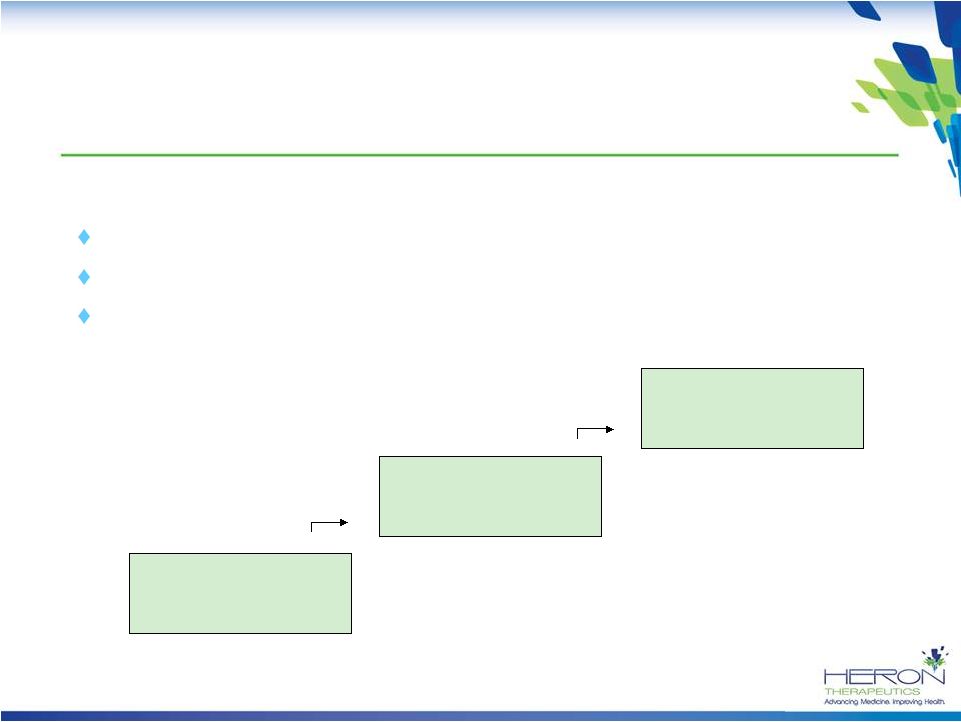 HTX-011 Phase 1 Single-Ascending-Dose Study
Cohort 1
100 mg HTX-011
(5 active:1 placebo)
Min 7-day Observation
Safety PK evaluation
Min 7-day Observation
Safety PK evaluation
Randomized, Single-Blind, Placebo-Controlled
3 Single Rising Dose Cohorts
144 hr pharmacokinetic & pharmacodynamic assessments
Cohort 2
200 mg HTX-011
(5 active:1 placebo)
Cohort 3
400 mg HTX-011
(5 active:1 placebo)
35
Design |
 36
Plasma Concentrations of Bupivacaine
Observed with HTX-011
0
100
200
300
400
500
600
0
24
48
72
96
120
144
Hours
HTX
-
011 100 mg
HTX
-
011 200 mg
HTX-011 400 mg |
 37
HTX-011 Provides Longer Duration of
Bupivacaine Release without a Large Initial Peak
* Exparel data extracted from FDA Clin Pharm review |
 38
Mechanical Detection Threshold Using
von Frey Fibers
*Combined placebo data from all cohorts |
 39
*Combined placebo data from all cohorts
Pharmacodynamic Effects of HTX-011
Correlate with Pharmacokinetic Profile |
 40
Safety
•
No serious adverse events or premature
discontinuations
•
No clinically relevant ECG changes
•
No clinically relevant laboratory changes
•
Only adverse events considered possibly related to
drug were associated with the subcutaneous
administration of the product: mild redness and
bruising at some injection sites |
 41
Summary
•
Initial Phase 1 experience validates target product profile for
HTX-011
•
Desired pharmacokinetic profile for both bupivacaine and
meloxicam achieved
•
Strong pharmacodynamic activity that correlated with
pharmacokinetic profile observed
–
Rapid on-set of action without a large, potentially negative initial
peak
–
2-3 days of stable bupivacaine plasma levels correlated to 2-3
days of anesthetic effects
•
All three doses were well-tolerated
•
Phase 1 results support immediate advancement into Phase 2
|
 42
Next Steps for Post-Operative Pain
Program
•
SAD evaluation to complete in 1Q15
•
Quickly initiate Phase 2 studies 2Q15
–
Bunionectomy study scheduled to start late 2Q
•
Completing toxicology for nerve-block and orthopedic
indications to allow expansion of program |
 43
Phase 3 Trial of Exparel®
in Bunionectomy
Michael Golf, et. al. Adv Ther (2011) 28(9):776-788.
|
 POST-OPERATIVE PAIN PROGRAM
COMMERCIAL OPPORTUNITY |
 45
U.S. Post-Operative Pain Market
Source: Decision Resources, Post-Operative Pain Pharmacor, May 2006;
Decision Resources, Acute Pain, December 2012
•
Treatment options have remained stable over the past decade and new therapies are
expected to be dominated by reformulations of existing molecules
•
The
total
number
of
procedures
is
anticipated
to
increase
3%
per
year
driven
by
aging
population
•
Unmet needs include longer-acting local anesthetics, opioids with a more
tolerable side-effect profile and less addictive properties, and less
invasive delivery mechanisms 2012 Post-Op Pain Market (US only)
2021 Post-Op Pain Market (US only)
2012 Total: $3.1B
2021 Total: $3.6B
Strong
opioid
analgesics;
53%
Simple
analgesics;
11%
Dual-Acting
Opioids;
9%
Selective
COX-2
inhibitors;
9%
Local
anesthetics;
9%
Traditional
NSAIDs; 9%
Antiepileptic
Drugs
(AED);
1%
Strong
opioid
analgesics;
51%
Simple
analgesics;
13%
Dual-Acting
Opioids;
8%
Selective
COX-2
inhibitors;
5%
Local
anesthetics;
11%
Traditional
NSAIDs;
9%
Antiepileptic
Drugs
(AED);
1%
Novel
Emerging
Agents; 2% |
 46
>
72 hour Duration of Action Seen as “Ideal”
by Physicians, With 48 hours Minimally
Acceptable
Ideal
Duration
of
Efficacy
for
Long-
Acting Local Anesthetic
Efficacy for Long-Acting Local
Anesthetic
Source: Decision Resources Post-Operative Pain Physician Research
Initiative
2014
(N=30
qualitative
interviews;
N=184
quantitative
survey)
Minimally
Acceptable
Duration
of |
 47
Across Procedures, Many MDs Expect the
Use of Long-Acting Local Anesthetics to
Increase
Use of Long-Acting Local Anesthetics in the Future, by Procedure
Percentage of physicians indicating how frequently they expect
to use long-acting local anesthetics in the future
“Minimizing opioid use by using long-
acting local anesthetics is the trend. I
think the long-acting local anesthetics
have great promise in the future.”
–
General surgeon
Source: Decision Resources Post-Operative Pain Physician Research
Initiative
2014
(N=30
qualitative
interviews;
N=184
quantitative
survey)
10%
7%
5%
9%
6%
6%
5%
2%
7%
6%
7%
5%
3%
7%
3%
53%
60%
45%
62%
58%
58%
66%
44%
60%
60%
50%
41%
49%
47%
49%
37%
33%
49%
29%
36%
37%
28%
53%
34%
35%
43%
54%
48%
46%
48%
0%
20%
40%
60%
80%
100%
Cesarean Section
Cholecystectomy (outpatient)
Arthroplasty knee (outpatient)
Other non-OR therapeutic
procedures on musculoskeletal…
Treatment, fracture or dislocation
of hip and femur (inpatient)
Other fracture and dislocation
procedure
Repair of toe
Arthroplasty shoulder
Other therapeutic procedures on
muscles and tendons
Cholecystectomy (inpatient)
Arthroplasty other than hip, knee,
shoulder, or elbow
Hernia (outpatient)
Hip replacement, total and partial
Hernia (inpatient)
Arthroplasty knee (inpatient)
Less frequently
Same amount
More frequently |
 HTX-003
LONG-ACTING BUPRENORPHINE
FOR CHRONIC PAIN AND ADDICTION |
 49
30-Day Buprenorphine
Comparison to Competitive Products in Development*
*RB Pharma is from US2013/0210853; Camurus data from US2013/0190341
|
 Repeat Dose Model*
Therapeutic
range
*Prediction based on 15 mg dosed monthly
50
Excellent PK profile for once monthly dosing
Cmax achieves steady state by second dose |
 51
Partnering Opportunity for Long-
Acting Buprenorphine Products
•
Projected
sales
of
products
for
opioid
addiction
to
reach
$3B
by
2020
1
•
Recent deals for buprenorphine products show significant interest in the
space:
•
Titan license of Probuphine to Braeburn (12/17/2012)
•
6 month sub-dermal implant for opioid addiction with NDA submitted
•
$15.7M upfront, $180M milestones with double-digit royalties
•
Camarus license of CAM2038, long acting buprenorphine to Braeburn
(11/20/2014) •
Phase 2 program for opioid addiction and pain, with exclusive rights for North
America and option in Asia, Camurus retains ROW
•
$20M upfront, $131M in milestones with mid-teen royalty
HTX-003 Target Product Profile
•
30-day zero-order release of buprenorphine with single sub-Q
injection •
Low peak to trough variation allows for stable drug levels
•
Administered
by
medical
professional
with
very
low
potential
for
abuse
by
patients
1. Evaluate Pharma |
 52
Financial Summary
Summary Statement of Operations
(In thousands, except per share data)
Three Months Ended
March 31, 2015
Revenue
$
– Operating expenses
20,360
Other income (expenses)
(210)
Net loss
$ (20,570)
Net loss per share
1
$ (0.70)
Condensed Balance Sheet Data
(In thousands)
March 31, 2015
Cash and cash equivalents
$ 55,556
Total assets
$ 59,627
Total stockholders’
equity
$ 48,001
1
Based on 29.4 million weighted average common shares outstanding for the period
ended March 31, 2015 |
